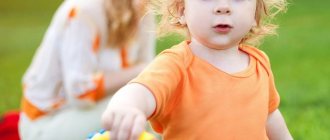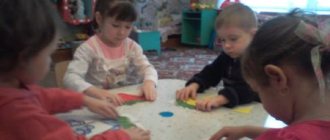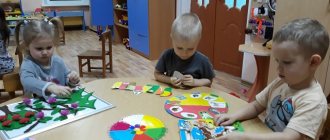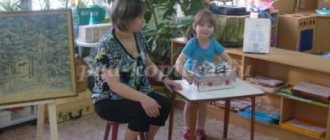MAGAZINE Preschooler.RF
Summary of a lesson on sensory development in the 2nd early age group Topic: “Rays of the sun”- Familiarize children with the geometric figure - circle.
- Learn to select objects based on color, display and verbal designation.
- To consolidate children's knowledge of colors and shapes.
- Develop imagination, memory, imaginative thinking.
- Cultivate curiosity, expand the experience of orientation in the environment, enriching children with a variety of sensory impressions.
Progress of the lesson: Organizational moment.
In the morning the sun rises Higher, higher, higher (we raise our hands up). By night the sun sets Lower, lower, lower (we crouch).
Okay, okay, the sun is laughing. And we all have fun under the sun. (Clap our hands) Surprise moment.
Oh, guys, where is our sun? There is no sun, our sun is lost, it’s so sad and boring without him.
The teacher invites the children to go on a trip not in search of the sun.
- Guys, let's go look for the sun, where is it hiding?
(children look in the corners, approach the doll’s crib)
— Educator: Let's see who's sleeping there? Yes, this is our sunshine.
Let's wake him up.
Physical education
Sun, sunshine, rise up (They show a circle with their hands) Look out the window (They wave their hands invitingly) So tired of waiting for you (They pretend to cry) Little crumbs. (They jump).
(The sun wakes up and asks).
- Who is screaming under the window, who is not letting me sleep?
Children: - This is us!
— Educator: Wake up, Sunny, we miss your warm rays so much.
— Sunny: Oh, guys, thank you for waking me up.
— Educator: Sunny, why are you so sad?
- Sunny: Rays - my children are lost
They ran across the fields and yards.
— Educator: Guys, look what the sun is missing? (Luchikov).
- What color are the rays of the sun (Yellow).
Educator: Guys, let's help the sun find its rays? (Yes)
(We go looking for rays, we meet a bunny).
Bunny, bunny, tell me Bunny, tell me, bunny, How can we find the rays of the sun? How can we get to them?
Didactic game “Halves Pictures”
- Guys, the bunny says that he will definitely show where the rays are hidden.
Only we have to help him collect the half pictures (apple, mushroom, carrot). Shall we help? (Yes)
Well done guys, you helped the bunny. And he told us where to go next. Well, are we going?
The legs began to walk, top-to-top, top-to-top, right along the path, top-to-top, tope!
Educator: Oh, guys, where should we go next? And I think I know who will help us. Look who's hiding behind the Christmas tree. Let's ask him.
Bear, bear, tell me. Bear, bear, show me. How can we find the rays of the sun? How can we get to them?
Didactic game “Match by color”
Mishka says we are going the right way. He will show us the way further, only asking us to help him “fix the car” (match the wheels by color).
The bear says thank you and shows us the path where the rays are hiding. Well, are we going?
The legs began to walk, top-to-top, top-to-top, right along the path, top-to-top, tope!
- Guys, look, what kind of house is it?
- This is probably a house where the rays of the sun are hidden. Let's look through the window (the Masha doll is sitting). Masha, Masha, tell me.
Masha, Masha, show me. How can we find the rays of the sun? How can we get to them?
Didactic game “Big and Small”
Masha says that we are very close and will come soon. But he asks us to help “sew buttons on the dress” (children select buttons by size)
Masha says thank you and asks us to take her with us.
We all go together to look for the rays.
We find a bright box (it contains yellow and blue clothespins)
Educator: Let's take and attach rays of clothes to the sun - clothespins, only yellow.
- Well done guys, what a beautiful sun we have created.
Lesson summary
- Well guys, it’s time for us to go back to kindergarten, let’s go.
- Let's remember who we helped today (bunny, bear, Masha)
- How did we help the bunny? (collected pictures)
- How did we help the bear? (they were repairing the car)
— How did we help Masha? (sewn on buttons)
- Who else did they help? (find some rays for the sun)
Did you enjoy our trip? I also really enjoyed our trip. Everyone was great today.
| Next > |
Abstract of OOD on sensory development in the second group of early age
Summary of OOD on sensory development for children 2-3 years old topic “Visiting the Sun”
Goal: Continue to form ideas about shape, size and color. Tasks: - create an emotional mood; — activate the child’s speech development and vocabulary; - develop cognitive interest, fine motor skills; - learn to distinguish between the number of objects “one - many”; continue to strengthen the ability to name primary colors; - develop children’s ability to play together. Vocabulary work: mushrooms, bunny, sun. Preliminary work: observing autumn phenomena in nature while walking, looking at illustrations, reading works of art. Equipment: Toy bunny and hedgehog, 2 baskets (large and small), mushrooms, green tablecloth, cardboard plates, semolina, sun, clothespins, balloons (yellow, red, blue), cardboard house, sun medals.
Progress of the lesson
I. Organizational moment. Guys, look, we have a lot of guests today. Let's greet them, say "hello." II. Now let's say "Good morning" to our hands . Good morning, hands, are you awake? (stroke hands).
Good morning, ears, are you awake?
(stroke ears).
Good morning, little eyes, are you awake?
(stroking eyes).
Good morning legs, are you awake?
(stroking legs).
We woke up, smiled and reached for the sun.
1) Surprise moment Oh, guys, where is our sun? There is no sun, our sun is lost, and for some reason it became so sad without him. - Guys, I suggest you go on an unusual journey. In search of the sun. And what you and I will travel on, you must now guess. Please, everyone, come to me. - Now I’ll draw what we will move on. - And you tell me what it is. (I draw with my finger on semolina). - What are these guys? (Balloons). - Yes, that's right, balls. And now each of you will draw a ball for yourself on which to go on a trip. (Children draw). — What shape is the ball? (Round). - Guys, look, your painted balls have turned into real ones. Look what color they are? (red, yellow, blue). And to make it more convenient for us to hold on, each ball has ribbons in the same color as the ball. Choose any ribbon for yourself, and we’ll go. (The song “Balls” plays) 2) Didactic game “one-many” - Guys, here we are, in a wonderful clearing. Look who's meeting us here. That's right, it's a hedgehog. Hedgehog, hedgehog, tell me Hedgehog, tell me, hedgehog, How can we find the sun? How can we all get to it? — Guys, the hedgehog says that he will definitely tell you where the sun is hiding. Only we must help him collect mushrooms in baskets. Shall we help? Yes! Oh, how many mushrooms grow here. Look at the mushrooms of different sizes. This is a big mushroom, and this is (answers). That's right, it's a small mushroom. We have two baskets, one is a basket (large) and the other (small). We will collect large mushrooms in a large basket, and small mushrooms in a small basket. How many mushrooms are in the baskets? (A lot of). How many mushrooms do we have? (None) Well done guys, you helped the hedgehog. And he told us where to go next. Well, are we going? The legs began to walk, top-to-top, right along the path, top-to-toe! 2) Game “Color and Shape” - Oh, guys, where should we go next? After all, there is a river ahead. How can we get through and get around the water? And I think I know who will help us. Look who's hiding behind the Christmas tree. Let's ask him. Bunny, bunny, tell me. Bunny, bunny, show me. How can we find the sun? How can we all get to it? - Guys, the bunny says that we are on the right path, we just need to build a bridge. And then there was a strong wind and it was destroyed. You need to put the boards in their places. Look, our river is wide, but the planks are narrow. Tell me, what color are our boards? (Red, yellow). Look how we will lay the planks. First we put down the red board, and then the yellow one. We will lay the planks evenly, plank to plank. Let's try it together. Which board will we place after the red one? (Yellow). Which one will we put after the yellow one? (Red). How many planks did we need to build the bridge (A lot). Look how smooth the bridge we have turned out to be. The bunny says thank you and offers to take us to the sun. Well, are we going? The legs walked, top-to-top, straight along the path, top-to-top! 3) Experimentation. Didactic game "Clothespins". - Guys, look, what kind of house is there? - This is probably the house where our sun lives. Let's look through the window. - Look, this is our sun, but for some reason it’s sleeping. Let's wake him up: 4) Physical education. Sun, sunshine, rise up (They show a circle with their hands)
Look out the window
(They wave their hands invitingly)
So tired of waiting for you
(They pretend to cry)
Little crumbs.
(They jump).
- The sun is waking up.
- Who is screaming under the window, who is not letting me sleep? Children:
- We are children!
- Wake up, sunshine, spring has come, and we miss your warm rays so much. — Sunny: Oh, guys, thank you for waking me up. - Sunny, why are you so sad? - Sunshine: The rays - my children - were lost Across the fields, scattered across the courtyards. - Guys, look what the sun is missing? (Luchikov). - What color are the rays of the sun (Yellow). - Let's attach some rays to the sun - yellow clothespins. - Look at the color of the clothespins here (yellow, blue). - You and I will only take yellow clothespins and attach them to the sun. - Well done guys, what a beautiful sun we have created. - What geometric figure does our sun look like? (Circle) (The teacher shows a geometric figure, a yellow circle) - What can we do with a circle? (roll or place) - Let's try (invites the children to roll the ball) - Oh, what kind of sun is it, big or small? (Big) - What color is it? (Yellow) - How many rays does the sun have? (A lot) - Look at the sun’s rays everywhere: from the side, above and below. The sun needs a lot of rays to warm everyone, the children, the grass, the flowers, and the birds. This is what kind sunshine we have. What a wonderful sunshine! All the guys were petted. So that you grow up strong, healthy and kind as the sun. And the sun gives each of you a piece of itself (those little suns). So that they will always be near you and warm you. III. Summary of the lesson - Well guys, it’s time for us to go back to kindergarten. Grab your ribbons, we're leaving. (The song “Balls” plays) - Guys, we are back in kindergarten, in our group. - Let's remember who we helped today (bunny, hedgehog, sun) - How did we help the hedgehog? (collected large and small mushrooms in baskets) - How did we help the bunny? (built a bridge from planks) - How did we help the sun? (the rays found it) Did you like our trip? I also really enjoyed our trip. Everyone was great today. IV. Sources of information 1. T.V. Bashaeva “Development of children’s perception. Shape, color, size" Moscow "Mosaic-Sintez", 2013. 2. L.A. Vartan “Sensory development of preschool children” Moscow “Mosaic-Synthesis”, 2014. 3. E.I. Udaltsova “Didactic games in the education and training of preschool children” Moscow “Vlados” 2003 4. N.E. Veraksa “FROM BIRTH TO SCHOOL” Moscow “Mosaic-Sintez”, 2014
We recommend watching:
Joint activities in an early age group. Synopsis of a lesson with children in the first year of life Synopsis of a joint educational activity for children of the 1st junior group “Winter-Winter” Complex thematic lesson in an early age group together with mothers
Similar articles:
Lesson summary for an early age group. Cockerel
Lesson summary for an early age group. Dandelion
Summary of a game developmental lesson in an early age group on the topic: Rays of the sun
Game development activity in kindergarten for children of the third year of life
Lesson summary for the first early age group on the topic: Toys
The role of sensory development
The main tasks of sensory development of preschoolers include:
- social adaptation of children to the world around them, development of their ability to recognize their sensations and respond correctly to them;
- accumulation of information about various properties of objects (size, color, shape, texture, temperature, sound, etc.);
- development and training of vision, hearing, smell and tactile analyzer in children;
- formation in children of memory, speech, objective thinking and perception of the outside world.
Young children learn life most easily and successfully through play. In the process of education for different ages, many approaches and games are used that can interest kids. This is important for successful classes and progress in sensory education and development of preschoolers.
The main goal of sensory development is to introduce the child to the outside world and the ability to freely navigate it. Children learn to distinguish different objects from each other by weight and shape, become familiar with their texture, learn to listen and distinguish individual sounds and music, and begin to divide colors into warm and cold.
The sensory development of preschool children is represented by several periods. Among them, the periods of 1-2 years and 3-4 years of life are important.
Games and exercises for sensory development
Children's games for the development of sensory perception take into account all the characteristics of age.
These include:
- interesting but easy to understand stories;
- presence of objects (cubes, sticks, figures);
- multiple repetitions of the material studied in the game;
- pointing and circling gestures;
- active and tactile activities (modeling, drawing, applique, etc.).
Games for training various types of perception (vision, touch, hearing) are based on working with the child’s senses.
"Bag of Secrets"
They take several different small objects (beads, pasta, cereals, etc.), show them to the child, pronounce all the names with him and ask him to remember them. After this, the parents ask him to turn away for a few seconds, during which they need to have time to sort the items into different opaque bags. The child is then asked to determine by touch what exactly is in each bag.
The game is great for training tactile sensations.
"Catch the Animal"
The child is asked to close his eyes, after which they take any plush toy and move it over different parts of his body. Then he is asked to identify and say where exactly the animal “ran” - along the arm, leg, stomach, etc.
The game is quite simple to implement, does not require a large number of props from parents, and is intended for the development and training of the sense of touch.
"Find the patch"
The child is offered several figures to choose from and asked to choose the one that matches the contours of the figure cut out on paper. The game trains vision, touch, logic and spatial thinking in general.
"Fragrant Joy"
They take several identical jars with different scents (creams, scented candles, etc.), give one of them to the child to smell, after which the jars are swapped and asked to determine by the smell which one was given to him earlier.
The game is great for training your sense of smell.
"Find a Pair"
The baby is given several toys that make different sounds and asked to choose the ones that sound the same. The game is suitable for training auditory perception.
"Imitation"
Parents name their child’s emotions (“anger,” “joy,” “sadness”) and accompany them with expressive grimaces. After this, he is called the same emotions and asked to repeat the corresponding grimaces.
All the games described above are an excellent tool in the education of preschoolers and contribute to the harmonious development of their sensory sphere.



